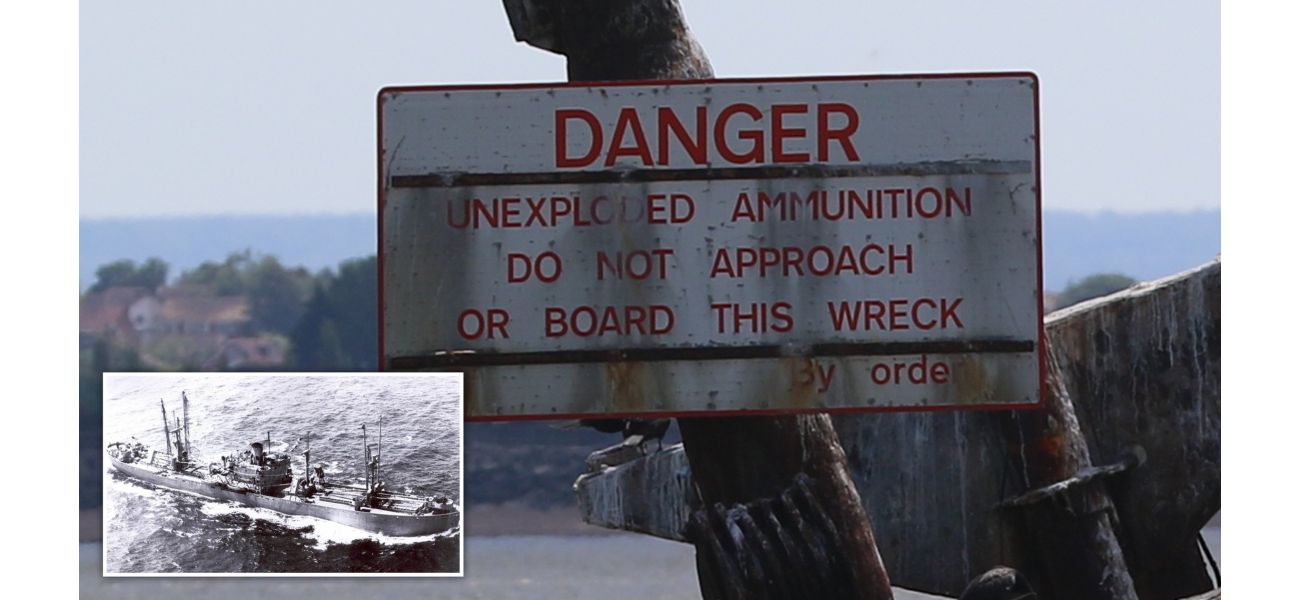A sunken ship filled with explosives could cause a potentially destructive tidal wave in the Thames.
New survey reveals WWII boat decaying faster than expected.
September 27th 2024.

According to a recent survey, the SS Richard Montgomery, a shipwreck carrying 1,400 tonnes of unexploded bombs, is deteriorating at an alarming rate. The ship, also known as the "Doomsday Wreck", sank in the Thames Estuary during World War II and has been underwater for 78 years. However, concerns have been raised about the ship's condition as its three masts, still visible above the water's surface, are at risk of collapsing and triggering a catastrophic explosion.
In addition to this, a Russian ship carrying 20,000 tonnes of explosive ammonium nitrate was recently spotted off the coast of Kent, adding to the urgency of the situation. The Department for Transport had already planned to remove the SS Richard Montgomery's masts, but a recent survey has shown that the ship is deteriorating at a faster rate than previously thought. As a result, the timetable for the removal has been moved up in order to ensure the safety of the public and reduce the risk posed by the wreck.
The department has stated that experts have conducted vital surveying work on the wreckage and based on their findings, the masts will be removed as soon as possible in the safest manner possible. However, the statement did not specify a timeline for the removal. The new report, released last week following a survey in 2023, revealed concerning findings about the ship's condition. It noted that the deck near hold three has collapsed on the port side and that the forward section of the wreck has increased in lean by 10 to 15cm.
The report also mentioned a crack along the second cargo hold that has grown wider and longer in the past year, potentially causing the ship to split in two. This could lead to the deck collapsing by up to 20cm per year. The ship was carrying 7,000 tonnes of explosives when it sank, and approximately 1,400 tonnes are still onboard. In addition to the deteriorating condition of the ship, the report also highlighted concerns about potential erosion of the supporting sediment, which could further destabilize the wreckage.
Rich Lehmann, chair of the environment committee at Swale Borough Council, expressed concerns about the ship's deterioration and stated that the council is closely monitoring the situation. Dialogue with the Department for Transport and other relevant agencies is ongoing to ensure that necessary precautions are in place to mitigate any risks to the community and the marine environment. It is also worth noting that in the event of an explosion, the ship's payload could cause a devastating tsunami and widespread destruction.
Earlier this year, Southend Labour councillor Lydia Hyde emphasized the urgency of the situation, stating that action must be taken as soon as possible. The potential impact of an explosion from the SS Richard Montgomery is grave, and it is essential that the necessary measures are taken to prevent any potential disasters. The safety of the public and the protection of the environment are top priorities in this matter.
A recent survey has revealed alarming findings about the current state of the SS Richard Montgomery, a World War II Liberty Ship that sank in the Thames Estuary near Sheerness and Southend-on-Sea in 1944. The ship, also known as the 'Doomsday Wreck' due to its cargo of 1,400 tonnes of unexploded bombs, is deteriorating at a much faster rate than initially expected. This has raised concerns about the potential risk of a 'Thames tsunami', should the explosives be triggered.
After being submerged for 78 years, the SS Richard Montgomery has succumbed to severe corrosion, causing the three masts that can still be seen above the water's surface to become unstable. There have been fears that these masts could collapse and ignite the dormant explosives, resulting in a catastrophic blast. These concerns have only intensified with the recent sighting of a Russian ship carrying 20,000 tonnes of explosive ammonium nitrate off the Kent coast.
The Department for Transport, which is responsible for managing the SS Richard Montgomery, had already planned to remove the masts as a safety precaution. However, the survey's findings have prompted them to bring forward the removal timeline. In a statement, the department emphasized their commitment to ensuring the public's safety and reducing any potential risks posed by the wreck. They stated that experts had conducted necessary surveying work and that they were revising their initial timeframe for the masts' removal to be as soon as possible, while also ensuring a safe and effective methodology.
The statement did not mention a specific timeline for the removal, leaving the question of when it will take place unanswered. The survey's report, released last week, highlighted some concerning observations made during a survey in 2023. It noted that the deck space near hold three had begun to collapse on the port side, which appeared to be a recent development. The report also mentioned that the whole forward section of the wreck had an increase in lean of 10 to 15cm, raising concerns about the supporting sediment eroding away.
Furthermore, the survey noted a 5cm increase in width and 37cm increase in length of a crack along the second cargo hold in just one year. This has caused significant buckling further down and has given the appearance that the forward part of the wreck is splitting in two. The report also highlighted a 20cm collapse in the deck above this area. The deteriorating condition of the back of the ship is also a cause for concern, with the report stating that it is potentially breaking in two about halfway along its length. This has caused a six-meter stretch of deck to collapse over half a meter in just one year.
Rich Lehmann, chair of the environment committee at Swale Borough Council, which covers Sheerness, expressed concern about the wreck's deteriorating state. He stated that the council was closely monitoring the situation and in communication with the Department for Transport and other relevant agencies to ensure necessary precautions are in place. He emphasized that the council's top priorities were the safety of the community and the protection of the marine environment.
The potential consequences of the SS Richard Montgomery's payload exploding are severe. A previous report from Medway Council warned that it could trigger a massive tsunami, causing destruction and death in its path. According to this report, the blast could launch a 1,000ft wide column of water, mud, metal, and munitions up to 10,000ft into the air, posing a threat to both wildlife and human lives. Additionally, researchers have stated that this explosion could rank among the world's largest non-nuclear explosions, causing widespread devastation.
Earlier this year, Southend Labour councillor Lydia Hyde expressed the urgency of the situation, stating that it was necessary to act as soon as possible. She mentioned that assessments conducted in the summer and November had revealed the masts' deteriorating condition, making immediate action crucial. The potential damage from the SS Richard Montgomery's explosives is not limited to the immediate area, as several areas could be severely affected. As such, it is essential to prioritize the removal of the masts and mitigate the risks posed by this 'Doomsday Wreck'.
In addition to this, a Russian ship carrying 20,000 tonnes of explosive ammonium nitrate was recently spotted off the coast of Kent, adding to the urgency of the situation. The Department for Transport had already planned to remove the SS Richard Montgomery's masts, but a recent survey has shown that the ship is deteriorating at a faster rate than previously thought. As a result, the timetable for the removal has been moved up in order to ensure the safety of the public and reduce the risk posed by the wreck.
The department has stated that experts have conducted vital surveying work on the wreckage and based on their findings, the masts will be removed as soon as possible in the safest manner possible. However, the statement did not specify a timeline for the removal. The new report, released last week following a survey in 2023, revealed concerning findings about the ship's condition. It noted that the deck near hold three has collapsed on the port side and that the forward section of the wreck has increased in lean by 10 to 15cm.
The report also mentioned a crack along the second cargo hold that has grown wider and longer in the past year, potentially causing the ship to split in two. This could lead to the deck collapsing by up to 20cm per year. The ship was carrying 7,000 tonnes of explosives when it sank, and approximately 1,400 tonnes are still onboard. In addition to the deteriorating condition of the ship, the report also highlighted concerns about potential erosion of the supporting sediment, which could further destabilize the wreckage.
Rich Lehmann, chair of the environment committee at Swale Borough Council, expressed concerns about the ship's deterioration and stated that the council is closely monitoring the situation. Dialogue with the Department for Transport and other relevant agencies is ongoing to ensure that necessary precautions are in place to mitigate any risks to the community and the marine environment. It is also worth noting that in the event of an explosion, the ship's payload could cause a devastating tsunami and widespread destruction.
Earlier this year, Southend Labour councillor Lydia Hyde emphasized the urgency of the situation, stating that action must be taken as soon as possible. The potential impact of an explosion from the SS Richard Montgomery is grave, and it is essential that the necessary measures are taken to prevent any potential disasters. The safety of the public and the protection of the environment are top priorities in this matter.
A recent survey has revealed alarming findings about the current state of the SS Richard Montgomery, a World War II Liberty Ship that sank in the Thames Estuary near Sheerness and Southend-on-Sea in 1944. The ship, also known as the 'Doomsday Wreck' due to its cargo of 1,400 tonnes of unexploded bombs, is deteriorating at a much faster rate than initially expected. This has raised concerns about the potential risk of a 'Thames tsunami', should the explosives be triggered.
After being submerged for 78 years, the SS Richard Montgomery has succumbed to severe corrosion, causing the three masts that can still be seen above the water's surface to become unstable. There have been fears that these masts could collapse and ignite the dormant explosives, resulting in a catastrophic blast. These concerns have only intensified with the recent sighting of a Russian ship carrying 20,000 tonnes of explosive ammonium nitrate off the Kent coast.
The Department for Transport, which is responsible for managing the SS Richard Montgomery, had already planned to remove the masts as a safety precaution. However, the survey's findings have prompted them to bring forward the removal timeline. In a statement, the department emphasized their commitment to ensuring the public's safety and reducing any potential risks posed by the wreck. They stated that experts had conducted necessary surveying work and that they were revising their initial timeframe for the masts' removal to be as soon as possible, while also ensuring a safe and effective methodology.
The statement did not mention a specific timeline for the removal, leaving the question of when it will take place unanswered. The survey's report, released last week, highlighted some concerning observations made during a survey in 2023. It noted that the deck space near hold three had begun to collapse on the port side, which appeared to be a recent development. The report also mentioned that the whole forward section of the wreck had an increase in lean of 10 to 15cm, raising concerns about the supporting sediment eroding away.
Furthermore, the survey noted a 5cm increase in width and 37cm increase in length of a crack along the second cargo hold in just one year. This has caused significant buckling further down and has given the appearance that the forward part of the wreck is splitting in two. The report also highlighted a 20cm collapse in the deck above this area. The deteriorating condition of the back of the ship is also a cause for concern, with the report stating that it is potentially breaking in two about halfway along its length. This has caused a six-meter stretch of deck to collapse over half a meter in just one year.
Rich Lehmann, chair of the environment committee at Swale Borough Council, which covers Sheerness, expressed concern about the wreck's deteriorating state. He stated that the council was closely monitoring the situation and in communication with the Department for Transport and other relevant agencies to ensure necessary precautions are in place. He emphasized that the council's top priorities were the safety of the community and the protection of the marine environment.
The potential consequences of the SS Richard Montgomery's payload exploding are severe. A previous report from Medway Council warned that it could trigger a massive tsunami, causing destruction and death in its path. According to this report, the blast could launch a 1,000ft wide column of water, mud, metal, and munitions up to 10,000ft into the air, posing a threat to both wildlife and human lives. Additionally, researchers have stated that this explosion could rank among the world's largest non-nuclear explosions, causing widespread devastation.
Earlier this year, Southend Labour councillor Lydia Hyde expressed the urgency of the situation, stating that it was necessary to act as soon as possible. She mentioned that assessments conducted in the summer and November had revealed the masts' deteriorating condition, making immediate action crucial. The potential damage from the SS Richard Montgomery's explosives is not limited to the immediate area, as several areas could be severely affected. As such, it is essential to prioritize the removal of the masts and mitigate the risks posed by this 'Doomsday Wreck'.
[This article has been trending online recently and has been generated with AI. Your feed is customized.]
[Generative AI is experimental.]
0
0
Submit Comment





